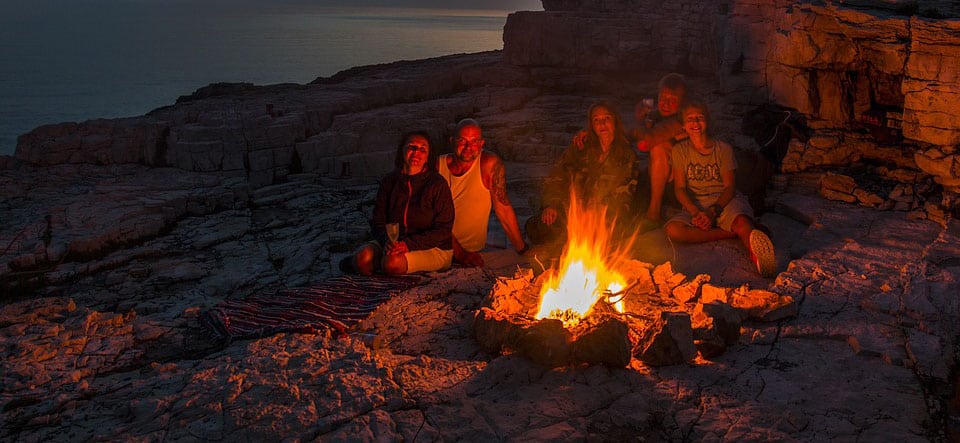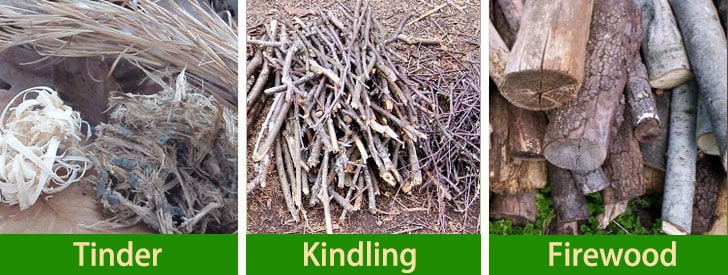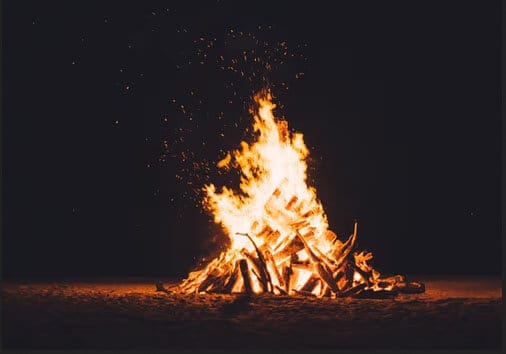
From history to modern tribes, it is the common culture that a group of people sitting around a campfire talking and dancing, such a moment always bonds with joy and happiness.
Maybe one of the most symbolic differences between humans and animals is the usage of fire. Such a concept that is carved into our brain as a result of evolution, shaping our civilization. Just sitting around a campfire in the wilderness, looking at the flames, can elicit the ancient emotions of good feelings.
For all this sake, it makes the campfire a great experience for a camping trip. However, it is not an easy task to build if you have not tried before. Also, there are a lot of safety issues you need to know, as everyones knows that playing with fire is a synonym of dangerous.
To solve your problem, we have compiled this complete guide covering every aspect you need to know about how to build a campfire.
Let’s get started.
Table of Contents
Safety first
Before you go, keep in mind that the most important rule is safety. Campfires can burn people, damage your gears (tents …), or even lead to a forest fire.
It is Especially important when you are camping with children. According to an article from NIH, they have seen a rising number of children with campfire burns, 88% being under 7. The children had either fallen into the campfire or walked into simmering coals.
It also has a potential threat on a large scale. Statistics show that nearly 85 percent of wildland fires in the United States are caused by humans, many of them result from campfires left unattended.
Those numbers we list here are to give you a feeling on how serious the consequence is. You should take more attention and be careful when doing such things.
Always make the situation under control, limit the fire in a small range and keep an eye on it.
If you are camping with family, a best practice is keep a safe distance of 4 feet from the campfires by drawing a “circle of safety” with a stick on the ground 4 feet away from the fire, and Educate the children to keep away from those boundaries.
Remember to extinguish the fire before you leave.
Choose a safe site
Many campgrounds have designated fire rings, grills or fireplaces, if this is the case then go straight and use it.
In some areas campfires are not permitted, or they have strict guidelines about building fires, you should check in advance with the agency that administers the land.
Choose an open,level location, at least 15 feet from tent walls, shrubs, trees or other flammable objects. Make sure there are no low-hanging branches, and other heavy fuels like logs, brush or decaying leaves.
Wind is an important factor too, don’t build a fire at the upwind direction of your tent. If possible, choose a spot that’s protected from gusts.
This is especially important when you are camping with family or friends using a large tent, which has a higher chance to catch fire when you build it too close to the tent.
Prepare the campfire pit
After locating the fire site, you should remove any grass,twigs,leaves and other wood around the perimeter. As a rule of thumb, a 10-foot diameter is the common practice.
Then dig a one foot deep pit. To keep the fire safely under control, circle the pit with stones, you can also use other things like dirt if rocks are not available.
Gather firewood
To build a fire, different tiers of fuel are used. We need something very easy to ignite first, then using them to ignite something much durable but still easy to burn. At last we ignite the heavy wood that consists of the main fuel of the campfire.

Those three types of materials are: tinder,kindling,and firewood.
Tinder
Don’t confuse it with the mobile app, this is a fire material that is very easy to burn, usually they are small twigs, dry leaves, needles, or forest duff. You can also use papers if there is no choice.
Kindling
Kindling is usually small dry sticks, they are thin but much more durable to burn than tinder,typically less than one inch around.
Firewood
This is a large piece of wood that keeps the fire going. Usually they are big branches or trunks of the wood. You can bring an axe and cut it into small pieces to make it easier to burn.
Difference between campgrounds and backcountry-style camping
For campgrounds, you can buy them from the nearby stores, don’t bring your own firewood, many of the campground bans it to avoid introducing troublesome insects into the local ecosystem.
For backcountry-style camping, you need to gather them on your own. If there are trees, there are dry sticks and twigs. From our experience this is an easy task.
Don’t cut live trees or break off branches from standing trees, they are wet and have a lot of smoke when they burn.
Prepare
Now it’s the time to prepare the material and assemble them into a structure that is ready to burn.
Roughly we have three types that have been used in common practice. You can also do any free style by mixing part of them as you wish.

The main goal of all these structures is to let the firewood burn with enough airflow. You should have noticed that the vent is vital in any form of it. When the fire is burning, fire and the hot air flows top, so you must leave some holes in the ground to let the cold air with enough oxygen come through that forms a full circulation to maintain the chemical reaction of the burning process.
Teepee or cone
As the name says, the logs are set up vertically leaning towards the center against each other to form a cone shape. Tinder and kindling are filled in the center.
You can build the fire in two steps, use the kindling to build a cone with tinder in the center, light them first, once the kindling is ignited and burning, then add the large piece of firewood gradually to form an outer cone.
Log cabin
Place two large piece of firewood in parallel with some space in between, then add two similar firewood perpendicular on it to form a # shape. Follow the pattern and add more layers on top of it.
Tinder and kindling are placed in the central square, once the firewood is burning and stable, you can add more wood on top of it as you wish.
Pyramid or Platform
This is much like the log cabin type, but more logs are placed close to each other per layer, stacks up at least three layers to form a platform.
Tinder and kindling are placed on top of it. The top burns first and will burn down gradually, so you don’t need to add fuel during the process. This is why it is also called upside-down.
This is a useful structure for cooking.
Light the campfire
Finally, we come to this most exciting part, let there be light!
The key ingredient is tinder and kindling, make sure you have enough tinder, many people fail at the first try because the tinder burns out quickly.
Matches and Lighter
Remember to bring a match or lighter, or a fire starter that is specifically designed to ignite a fire.
Make sure the match and lighter are waterproof. There are many unpredictable conditions in the wilderness and you should make sure they are working in the worst scenario.
Ignite Tinder and Kindling
For the cone and the log cabin type, don’t start with the logs at first. You can add and place them after the kindling is burning stable.
First you should make a tinder bed, and place the kindling on top of it to form a cone shape or login carbin shape as you wish. Make sure you have enough tinder to ignite the kindling.
Then light the tinder, a useful tip is light a paper (toilet paper is good) then place it under the tinder, the paper should burn quickly and form a large flame that ignites the tinder.
In some cases, the fire is not burning as expected, you can blow or swing your hand lightly at the base of the fire to accelerate the air flow and give more oxygen to feed the fire.

Put the thinner kindling closer to the tinder as they are easy to burn. You can add some tinder on top of the kindling to make the flame bigger and last longer to ignite the kinding.
You may fail at the first few tries, don’t be frustrated, it’s common even for a more experienced camper.
Remember, don’t use gasoline or diesel to light a campfire, it is dangerous and tends to explode.
Add firewood
As the kindling burns to a stable state, you can add the large piece of firewood gradually. Forming the cone or log cabin shape.
Add more kindling to the fire as time comes by to maintain the fire until the large firewood starts burning stable.
Maintaining the fire and keep it under control
Congrats! When the firewood burns it means the fire is totally built. Now you should maintain the fire and keep it burning. It only costs you a little time but you should always keep an eye on it.
Add more fuel if necessary, but don’t add too much at one time, just enough to keep it going and maintain the flame to a certain extent.
Move the embers to the center to ensure it burns completely.
Keep your children at least four feet away from the fire. You can draw a circle around the fire using stones or dirt, and tell them to keep away from the boundary.
Remember, always keep the fire under control.

Extinguish the fire
Make sure to extinguish the fire before bedtime. If you leave it unattended, unpredictable conditions like gusts may blow it to your tent that creates disaster.
Pouring water on the fire to extinguish it, you can do this slowly to avoid cracks that may cause some small part bouncing out.
If water is not available, you can use dirt or sand. Throwing dirt on the fire will cut off the fuel’s contact with air, it works, but it can’t extinguish the embers beneath immediately. You need to wait a little longer to make sure everything is clear.
It is a wise way if you stop fueling the fire one or two hours early before bedtime and let it burn totally into ashes. Put your hand one or two inch away from it to test the temperature, and use a stick to check whether there are embers inside.
The same rule also applies at the end of your camping trip. Remember to extinguish the fire and eliminate the potential probability of it becoming a forest fire.
Clear up
Don’t throw plastic bags into the fire, it will decompose into toxic compounds when burned, which is not good for your health and also bad for the environment.
If you are in a campground make sure to follow their rules on how to extinguish the fire and clear up the pit.
For backcountry camping, you need to clear the trash and dismantle any structure you have built. Scatter the dust and ashes in a broad area, or bury them. Leave no trace if possible, this is a good camping etiquette.
Summary
So that’s it, you already got the knowledge. With proper preparation and careful actions, a campfire can greatly improve your camping experience. It is always full of happiness and joyful memories with people sitting around the campfire, singing and dancing.
Keep Reading:

 CuteCamper
CuteCamper
